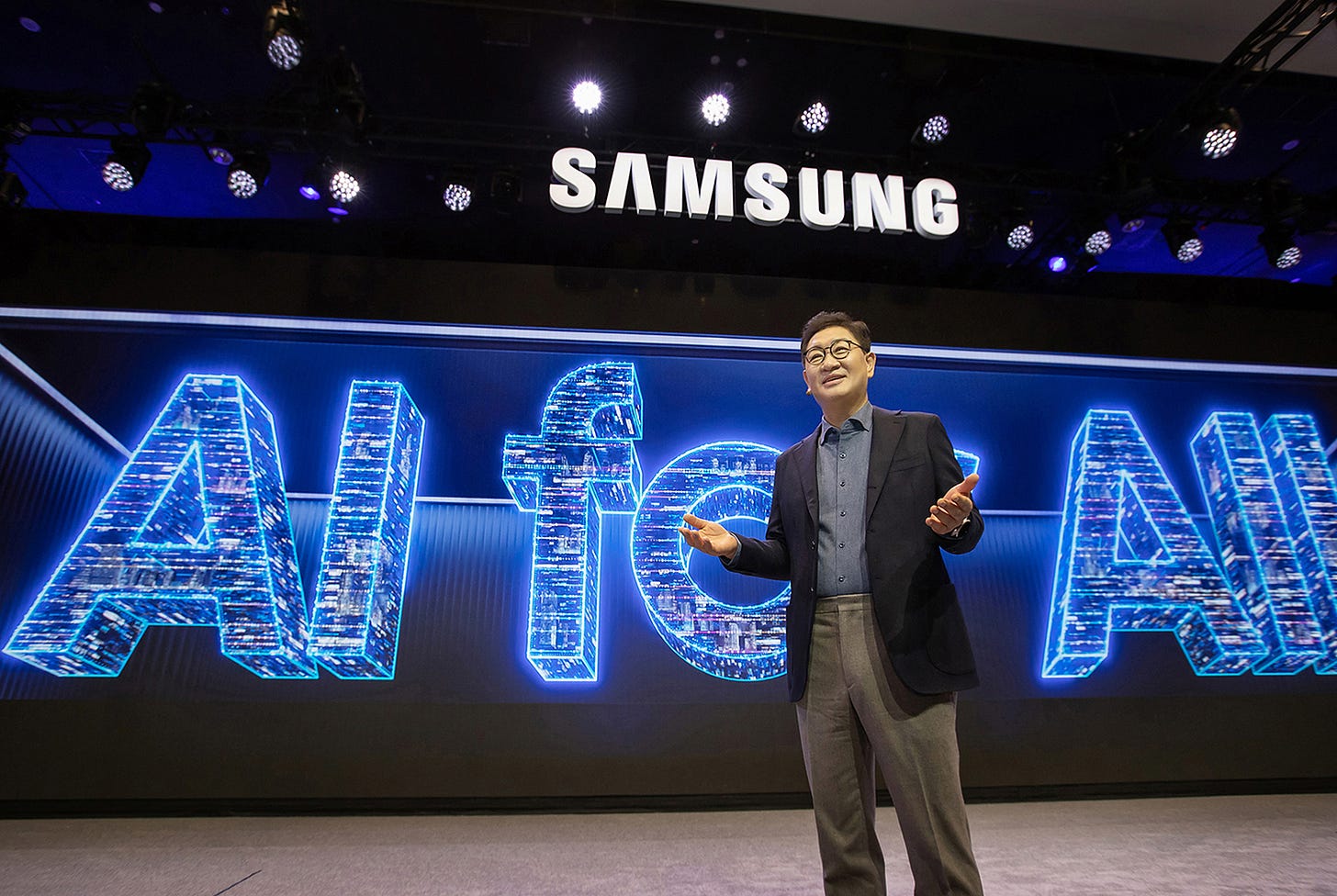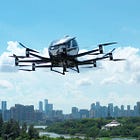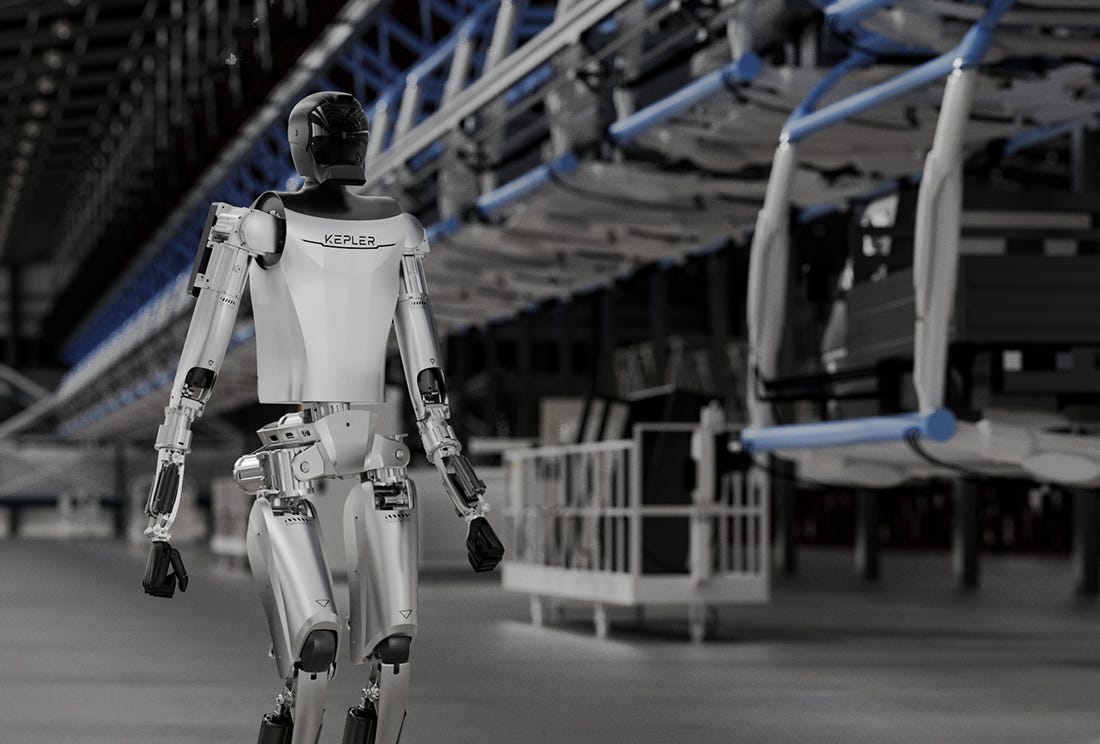My aim when writing this newsletter is to help you anticipate and understand what’s coming next, and how you should respond. And watching the coverage of CES from London this week, it’s clear that we’re entering a new phase in the AI era (already, just over 12 months since it ignited!).
In 2024, AI will come to the physical world as much and as fast as it did to the digital world in 2023. Intelligence is going to be everywhere, not just on our screens. And the robots are coming, for real this time.
Spotting that is easy (it’s not like it’s hidden in Vegas!). The hard part is knowing how to respond. What questions you should be asking your colleagues? I think there are two big, unavoidable questions that any brand with a physical presence will need to ask in the next 12 months:
1. What does ‘intelligence’ look like in [your industry]?
2. Will you put robots front and centre of your brand and customer experience, or make them invisible?
As always, these aren’t really technological questions. They are human experience questions. But keep reading for some thoughts on how to successfully answer them.
Note: Despite being written in 2023 (😱!), there’s still loads of practical insights in my year-end wrap, which contains 52 questions to help you anticipate and understand what’s coming in 2024.
1. What does ‘intelligence’ look like in [your industry]?
You don’t need me to tell you that, unsurprisingly AI is embedded into everything at CES this year. You can put these AI gadgets into a few buckets:
Expected / obvious – e.g. Volkswagen’s in-car assistants, Samsung’s recipe-suggesting fridge, Nowatch’s stress-reducing smartwatch, and Mojawa’s sports-coaching earphones;
More novel – e.g. Rabbit’s R1 not-a-phone AI handheld, MM-Guardian’s child-friendly smartphone, Timekettle’s multi-language real-time translation headphones, 10minds’ snore-preventing Motion Pillow, Rezet’s sleep-enhancing mattress topper, Baracoda’s mental health-monitoring and -boosting mirror, Swarovski’s animal-identifying binoculars, Lamborghini’s driving monitor and coach, and Invoxia’s health- and GPS-tracking dog collars;
Faintly ridiculous – e.g. Flappie’s dead mouse-blocking cat flap, Bird Buddy’s smart bird feeders, Seer’s BBQ grill and Skyted’s voice-shielding facemask.
Your response to this deluge of AI, everywhere all at once shouldn’t simply be to “put AI in our products, now” (you’re undoubtedly already working on that ;) Instead, ask a deeper question: “what does ‘intelligence’ look like in our industry, and most importantly, for our customers?”
It’s easy to laugh at some of the gadgets I’ve put in the novel and ridiculous buckets – does anyone need a smart bird feeder?! But look deeper and it isn’t actually all that ridiculous at all to alert people when a bird is at their feeder, and to help them identify and track which species of bird they see. Doing so gives people exactly what they want when they buy a bird feeder.
A few caveats. ChatGPT was the tool that broke the AI dam because of its radical accessibility. Free is a compelling price, and it ‘just worked’ – with simple inputs and clear outputs. Too many AI-powered gadgets are both complex or inconvenient to manage, and questionable in their outputs. On top of this most of the products above are hugely expensive and require pricey ongoing subscriptions. That’s a big ask for some fun extra functionality that you might not use regularly.
Instead, take inspiration from 2024’s breakout CES success Rabbit. Start with the pain points and unmet needs of your customers – in their case, smartphone and app fatigue. How might AI enable you to address them intelligently? Can you make it reliable, cheap and almost invisible? The best AI features will be quickly unremarkable – your goal should be to create an experience that feels magical today, but will simply be expected tomorrow. That’s true intelligence.
2. Will you put robots front and centre of your brand and customer experience, or make them invisible?
Of course the robots were out in force at CES. They ranged from Kepler’s $30k general purpose humanoid robot to Samsung’s domestic companion robot, Ballie (complete with in-built projector), to Moxie’s child education and development-focused robot, ElliQ’s eldercare robot, MOBINN’s stair-climbing delivery robot, and many more.
Because if 2023 was all about talking with chatbots, then 2024 is going to be the year that robots start to become increasingly smart, capable and ubiquitous. The pace of advancement feels like the early weeks of ChatGPT – in the last month alone Tesla launched the impressively dextrous second generation of its Optimus humanoid robot, Figure’s 01 robot taught itself to make coffee simply by watching humans do the task, researchers at Stanford created an open source low cost robot Aloha. And we’re hardly at ground zero – Amazon already has 750,000 robots in its logistics centers (up from just 1,000 ten years ago!), and is now trialling its Digit humanoid robots.
For executives and marketers however, the biggest strategic question when it comes to robots isn’t “will we use them?” (short answer: you will), but “how and where will we integrate them into our brand and customer experience?”
Because the world will fragment into two camps: those brands that lean into robots to deliver a low/no-touch automated experience, and those that move in the other direction and focus on delivering high-touch, human-led experiences (keeping their robots largely out-of-sight from their customers).
The obvious prediction will be that premium brands will employ humans to serve their customers, while mass market brands will leverage robots to automate as much as possible.
However I suspect it will be more nuanced, and that countless fascinating new, robot-adjacent roles will emerge. For example, imagine a coffee shop which uses robot baristas to make its coffees (every one bespoke and perfect, of course). Could the time that the human baristas save mean that, instead of being stuck at the coffee machine, they could be out in the shop with customers – educating them on the product they’re buying and so increasing their enjoyment?
So – which type of brand will you be when it comes to robots and your customer experience? And what new robot-related roles will emerge in your organisation?
What’s the future normal for YOUR organisation in 2024?
I have delivered 150+ actionable keynotes and workshops in 30+ countries, bringing audiences fresh perspectives on what’s next.
To discuss your next meeting or event then please reach out directly to Renee Strom or check out my speaking site.
Here’s what Cassie Gasson, Thrive’s CMO had to say about it:
“Henry was recommended to us and he didn't disappoint! Despite the short notice due to a last-minute keynote dropout, Henry spent time on the phone with me the day before to perfectly understand our audience and tailor his talk to what L&D cares about. I'd definitely recommend Henry to anyone looking to deliver a session on a fresh take on AI and the future normal!”
Some other recent feedback:
“My go-to speaker for future-gazing grounded in reality is always Henry. He's a fantastic speaker who fills big rooms and gets high praise on feedback forms. It's refreshing to work with someone who puts so much time and effort into making a killer keynote – free from the BS and hype that's often prevalent in this space!”
Dan Brain, Founder, MAD//Fest
Thanks for reading,







